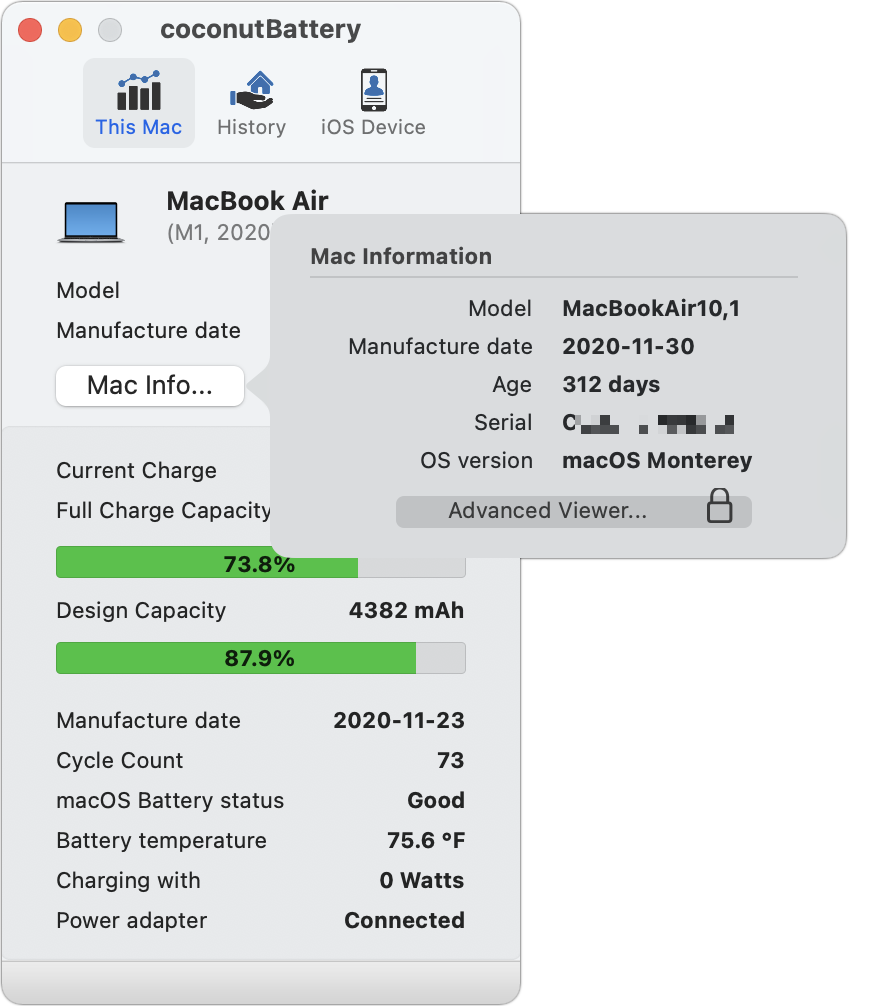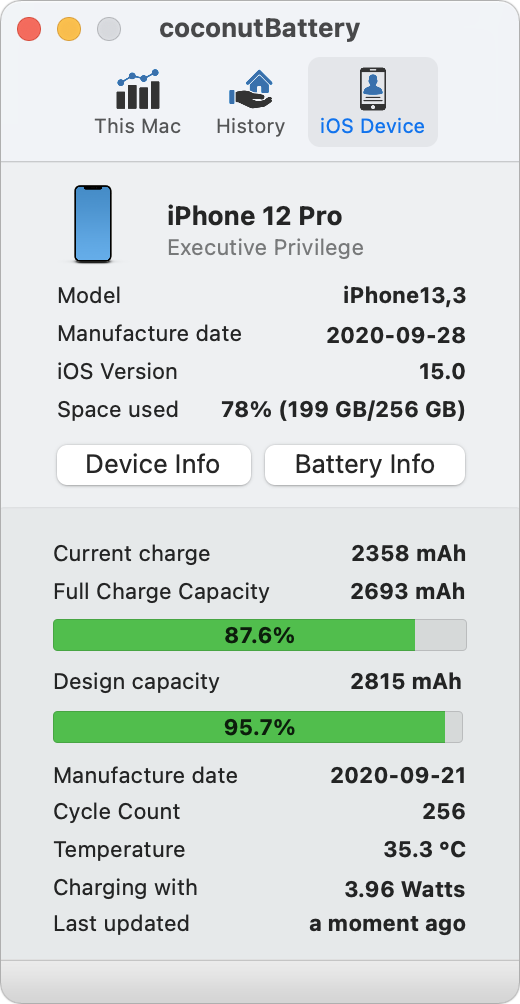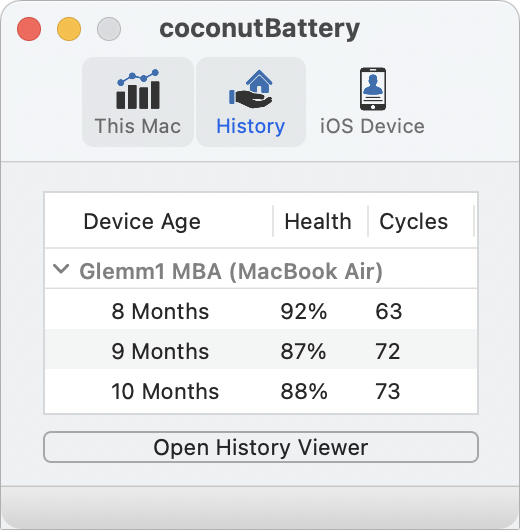
At a glance
Expert’s Rating
Price When Reviewed
$9.95 (14-day free trial)
Best Prices Today
Monitoring the battery status of our Mac laptops used to be an absolute necessity. When not plugged in, you had to prioritize and manage tasks carefully to avoid your Mac, iPhone, or iPad shutting down with work (or fun) left to do. And batteries lost capacity in years past rapidly, sometimes by percentage points each week.
 https://b2c-contenthub.com/wp-content/uploads/2021/10/mac-gems-coconutB-mac-details-bordered-1.png?resize=261%2C300&quality=50&strip=all 261w, https://b2c-contenthub.com/wp-content/uploads/2021/10/mac-gems-coconutB-mac-details-bordered-1.png?resize=768%2C884&quality=50&strip=all 768w" width="874" height="1006" sizes="(max-width: 874px) 100vw, 874px" />
https://b2c-contenthub.com/wp-content/uploads/2021/10/mac-gems-coconutB-mac-details-bordered-1.png?resize=261%2C300&quality=50&strip=all 261w, https://b2c-contenthub.com/wp-content/uploads/2021/10/mac-gems-coconutB-mac-details-bordered-1.png?resize=768%2C884&quality=50&strip=all 768w" width="874" height="1006" sizes="(max-width: 874px) 100vw, 874px" />IDG
coconutBattery emerged nearly two decades ago as a simple battery-management tool. It’s matured over that time to provide a focused set of useful information about the charge and health of the battery built into your Mac and any iPhone, iPad, or iPod touch you connect via USB or, with an optional paid upgrade, over Wi-Fi.
The views for This Mac and iOS Device (iPhone and iPad) provide the basics needed for regular use, when preparing to go off power, and for keeping track of long-term trends of a potentially failing battery.
You can see the current charge, what your Mac or mobile device considers its current 100 percent capacity (the Full Charge Capacity), and what coconutBattery labels as the design capacity—the maximum charge the battery should be able to hold when it leaves the factory. An option in the app’s preferences also lets you add a system menu that shows configurable details about battery status and optionally include iOS/iPadOS devices in the dropdown menu.
 https://b2c-contenthub.com/wp-content/uploads/2021/10/mac-gems-coconutB-iPhone-info-bordered.png?resize=155%2C300&quality=50&strip=all 155w" sizes="(max-width: 520px) 100vw, 520px" />
https://b2c-contenthub.com/wp-content/uploads/2021/10/mac-gems-coconutB-iPhone-info-bordered.png?resize=155%2C300&quality=50&strip=all 155w" sizes="(max-width: 520px) 100vw, 520px" />Many of these statistics are useful to look at while anticipating going mobile for tens of minutes to several hours. They might help decide whether you should pack a USB battery pack, for instance, or charge for longer. But I recommend taking a look at the design capacity percentage regularly, too.
With coconutBattery running or every time you launch it, the app records statistics for the device’s age (based on a date Apple encodes in it), the current maximum percentage of design capacity (as Health), and the number of cycles it’s been charged. (Cycles measure 100 percent charge, so discharging 50 percent and recharging to full is a half cycle.)
This revealed to me that my M1 MacBook Air battery has taken a real hit, according to the History view in the app. Delivered in December 2020, at 8 months, it was already down to 92 percent capacity at 63 cycles; at 10 months, right now, and 74 cycles, it can only hold 85 percent. That means it’ll be certainly be due for a warranty replacement in a few months. (Remember that Apple’s 1-year device warranty covers a battery that drops below 80 percent maximum capacity in that period, and AppleCare+ during any point while it remains in effect for Macs, iPhones, and iPads.)
If you’re concerned about if or how fast your Mac or mobile device is charging, you can see whether a power adapter is connected and the wattage at which power is transferring.
 https://b2c-contenthub.com/wp-content/uploads/2021/10/mac-gems-coconutB-failing-mac-battery-bordered.png?resize=294%2C300&quality=50&strip=all 294w" sizes="(max-width: 520px) 100vw, 520px" />
https://b2c-contenthub.com/wp-content/uploads/2021/10/mac-gems-coconutB-failing-mac-battery-bordered.png?resize=294%2C300&quality=50&strip=all 294w" sizes="(max-width: 520px) 100vw, 520px" />The app also gives you access to more general information about your Mac, iPhone, or iPad, and a variety of technical details, too. Click Mac Info/Device Info in the This Mac or iOS Device views and you can pull up the serial number and age.
The developer, coconut-flavour.com, offers a paid upgrade—or a “support this app” contribution—that you can test out the features of for the first 14 times you start up the app. For a one-time $9.95 fee, you can view iPhone and iPad battery details via Wi-Fi (by enabling an option in iTunes or the Finder), access advanced information about your Mac, iPhone, or iPad, and track your mobile device’s battery health history. You can also receive notifications on your mac.
coconutBattery provides an excellent baseline of battery information and a historical accounting that may let you anticipate a fading battery while still under warranty—or to decide if you want to keep eking out its lifetime before paying to have it replaced.
Though coconutBattery is nearly 20 years old and approaching its version 4 release and Macworld has previously mentioned it, this is its first review.
Welcome to the return of Mac Gems, a column that ran for many years and highlighted great nuggets of Mac software—apps that have a high utility, have a sharp focus on a limited set of problems to solve, and are generally developed by an individual or small company. With the strong resurgence of the Mac in recent years, we want to celebrate tools we use and that readers recommend to make the most of your macOS experience. Stay tuned for weekly updates, and send your suggestions to the Mac Gems Twitter feed (@macgems).





